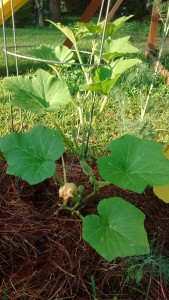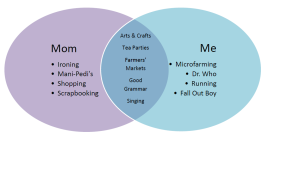We’ve been gardening since we got our first “real” house in 2011, and each season includes at least one grave tactical error (Ahem, “learning experience,”). They all come down to one problem – Every year I try to outsmart myself, and it never, ever works.
This year, I outsmarted myself twice: I got antsy, and fancy-pantsy.
The antsiness was building for a long time. Down here in Alabama, we have three seasons: mold, pollen, and football. Which translates to four planting seasons: early spring (January), early summer (April), late summer (July), and fall/winter (September). We skipped the January planting this year, and by March I was drooling and making lists with a crazed zeal of frightening proportions.
When I checked the FDA Zone Chart, I discovered that our planting date had been moved back by two weeks. Two weeks, y’all! I scheduled seeds-in-dirt-day for the first possible moment, which turned out to be just after Spring Break.
And Spring Break sowed the doomed seed of my fancy-pants downfall — Mimi came to town. Now, I have to stipulate, none of this is Mimi (my mother-in-law)’s fault. She was just along for the ride. But it can’t be denied that if Mimi weren’t here, I never would have fallen prey to the lure of Zentangle.
Have you heard of Zentangle? It’s a new-ish trend in group art experiences. You learn to draw certain intricate patterns and use them to make meditative, mehindi-like designs. It’s incredibly relaxing and immersive. You can lose hours doing it (Okay, I can lose hours doing it.) and they’re so pretty!
Let’s back up. My mother-in-law and I are very different people who also have a lot in common. It makes for a lovely relationship. Here’s a basic summary of our similarities and differences:
Frankly, as far as Mom-and-me bonding time goes, you couldn’t pick a better winner than this. And doing the class gave me the epiphany that what I really needed was a Zentangle-inspired garden. So my doodling turned into this:
Looks awesome, right? Very mandala-ish. Every vegetable has a companion flower to boost pollination and reduce pests. Every bed has a lovely design. And I followed my plan really well. Ready for the reality check?
 Okra and sunflowers. Turns out, the FDA zone chart is full of it. Instead of planting two weeks early, I should have listened to the experienced gardeners around me and waited even longer. (Climate change, where are you when we need you?) Planting so early meant one round rotted in cold, damp soil. A second round struggled up and was lost to a late cold snap. And this, third round took a long time to establish. It’s still about a month behind and looking pitiful compared to my more patient neighbors. We had collards and a cabbage in this bed for a while, but the cabbage moths got them before any of my beneficial flowers could open. Verdict: FAIL.
Okra and sunflowers. Turns out, the FDA zone chart is full of it. Instead of planting two weeks early, I should have listened to the experienced gardeners around me and waited even longer. (Climate change, where are you when we need you?) Planting so early meant one round rotted in cold, damp soil. A second round struggled up and was lost to a late cold snap. And this, third round took a long time to establish. It’s still about a month behind and looking pitiful compared to my more patient neighbors. We had collards and a cabbage in this bed for a while, but the cabbage moths got them before any of my beneficial flowers could open. Verdict: FAIL.
 This entire bed was planted in peppers and petunias. There would have been a lot more coverage with seeds, but I wound up replacing them with more expensive bedding plants. FAIL.
This entire bed was planted in peppers and petunias. There would have been a lot more coverage with seeds, but I wound up replacing them with more expensive bedding plants. FAIL.
 This is a climbing summer squash called Trombocino, that’s resistant to vine borers and squash bugs (the bane of my existence). It also makes enormously long, slightly naughty-looking green squashes that are supposedly shaped like a trumpet. (I wouldn’t call it that.) Trombocino is interplanted with bush green beans and dill, which repels pests. It did pretty well, so far. WIN.
This is a climbing summer squash called Trombocino, that’s resistant to vine borers and squash bugs (the bane of my existence). It also makes enormously long, slightly naughty-looking green squashes that are supposedly shaped like a trumpet. (I wouldn’t call it that.) Trombocino is interplanted with bush green beans and dill, which repels pests. It did pretty well, so far. WIN.
Here’s the drawing of what the pea and savory bed was supposed to look like:
Here’s what I actually got:
 See that huge swath of pine straw, with a few little sprigs sticking up? Two or three stalks of savory, and a smattering of peas. See, weeds don’t care about the weather. They actually like shady, damp days and all that bare ground waiting for seedlings to sprout. After several back-breaking rounds of weeding, I realized that at least some of the unidentifiable sprigs I was pulling might not be weeds. (Gulp.) So I backed way off and let everything grow until I could be sure I recognized everything. (There’s a Bible story about that, isn’t there?) As a result, the bed was completely drowned in weeds until last week, when I did a scorched-earth yank and smother. FAIL.
See that huge swath of pine straw, with a few little sprigs sticking up? Two or three stalks of savory, and a smattering of peas. See, weeds don’t care about the weather. They actually like shady, damp days and all that bare ground waiting for seedlings to sprout. After several back-breaking rounds of weeding, I realized that at least some of the unidentifiable sprigs I was pulling might not be weeds. (Gulp.) So I backed way off and let everything grow until I could be sure I recognized everything. (There’s a Bible story about that, isn’t there?) As a result, the bed was completely drowned in weeds until last week, when I did a scorched-earth yank and smother. FAIL.
 In this bed, you can see how the greens are dwarfing the poor baby okra. Salad: WIN. Okra: FAIL.
In this bed, you can see how the greens are dwarfing the poor baby okra. Salad: WIN. Okra: FAIL.
In the bottom right corner is one of the new seeds I tried this year: Jewels of Opar, aka Fame Flower.
Its long panicles of tiny purple flowers don’t show as well here, but you can see them in all their glory at Southern Exposure Seed Exchange, where I discovered it. My favorite thing so far about this veggie is the origin of its name – a riff on an old Tarzan novel!
I’m tempted to invent some sort of spicy dish with it, and call it “The Flaming Gods of Opar.” Suggestions welcome. WIN.
Another experimental plant for us: Amaranth.
 You can cook the leaves like spinach, and when the flowers go to seed, you get an easy-to-harvest grain (so they say). Amaranth recipes, anyone? WIN.
You can cook the leaves like spinach, and when the flowers go to seed, you get an easy-to-harvest grain (so they say). Amaranth recipes, anyone? WIN.
Now, this bed took a while to get going, but it worked. Cucumbers over bush beans.
 Hard to get complicated with that. WIN.
Hard to get complicated with that. WIN.
The blueberries are coming in well. I’m picking 2-5 cups every other day.
 Now that’s simple and perfect. BIG WIN.
Now that’s simple and perfect. BIG WIN.
This comedy of fancy-pants errors taught me the importance of simplicity.
- You can’t outsmart Mother Nature, or seasoned gardeners. Neither of them pays attention to some number on a website, but wait patiently for tried-and-true cues.
- There’s a reason gardeners sow in boring, straight rows, and it’s not because they’re boring people. Rows mean you know what’s coming up where, and you can keep your soil mulched properly so you don’t have to fight weeds all the time.
Lesson learned. A simple plan that works is prettier than a bunch of paper and ink.
How about you? Do you ever outsmart yourself and pay the price later?


